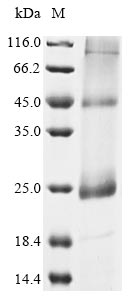Recombinant Human herpesvirus 6B Protein U22 is produced through an in vitro E.coli expression system. This full-length protein spans amino acids 1-202 and includes an N-terminal 10xHis-tag that helps with purification. The protein reaches purity levels above 85%, verified through SDS-PAGE analysis. It's designed for research use only, with no tested activity or specified endotoxin level.
Protein U22 from Human herpesvirus 6B appears to play a role in the viral lifecycle, though its specific functions remain largely unclear. Scientists study this protein to better understand virus-host interactions and the possible ways the virus persists and evades immune responses. Research on U22 seems crucial for grasping the biology of Human herpesvirus 6B and how it affects human health.
Potential Applications
Note: The applications listed below are based on what we know about this protein's biological functions, published research, and experience from experts in the field. However, we haven't fully tested all of these applications ourselves yet. We'd recommend running some preliminary tests first to make sure they work for your specific research goals.
Because E. coli cell-free systems lack eukaryotic chaperones, disulfide isomerases, and post-translational modification machinery, proteins of viral origin—particularly those interacting with host cell membranes or requiring complex folding—often misfold or remain in partially denatured conformations. There is no evidence that U22 folds autonomously in such systems. Therefore, while the recombinant U22 protein is valuable as a linear epitope antigen for antibody generation, immunoassay calibration, and sequence-based biochemical studies, it is unlikely to possess native tertiary structure or authentic bioactivity. Functional or binding assays based on folded conformations should only be pursued after appropriate refolding validation (e.g., circular dichroism or binding recovery tests).
1. Antibody Development and Validation
The recombinant U22 protein is well-suited for use as an immunogen in producing monoclonal or polyclonal antibodies, as its high purity and full-length coverage provide multiple linear epitopes. These antibodies can then be validated using this same recombinant protein in ELISA, Western blot, and immunofluorescence assays. If the native folding state is later confirmed or restored, the same antibodies could also be tested for recognition of conformational epitopes in infected cell models.
2. Structural and Biochemical Characterization
The protein can be used for biochemical verification, such as molecular weight determination, purity assessment, and limited proteolysis, but structural or biophysical studies like circular dichroism or NMR should only be performed after refolding validation. Because in vitro E. coli–expressed viral proteins often aggregate or remain unfolded, results from such analyses should be interpreted cautiously. If properly refolded, these methods could indeed characterize the secondary structure and stability of U22.
3. Enzyme-Linked Immunosorbent Assays (ELISA)
This His-tagged U22 protein can be used as a capture antigen in ELISA assays to detect anti-U22 antibodies in experimental samples. Its linear epitopes make it well-suited for such applications, and oriented attachment via the His-tag improves consistency. However, it should be noted that such assays will primarily measure antibodies recognizing linear epitopes, not conformational ones, unless the recombinant protein is refolded to mimic its native state.
Final Recommendation & Action Plan
The E. coli cell-free–expressed recombinant HHV-6B U22 protein is unlikely to fold correctly or display its native tertiary structure, given the expression system’s lack of post-translational machinery. Consequently, this protein is not suitable for native protein-protein interaction or functional studies without prior refolding validation. It is, however, well-suited for antibody development, ELISA-based immunoassays, and basic biochemical verification, where linear epitope presentation is sufficient.






